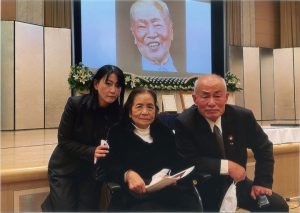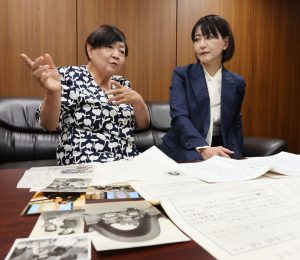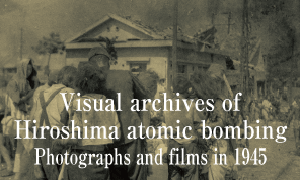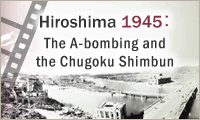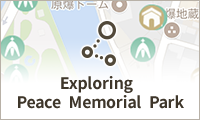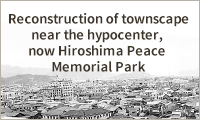Documenting Hiroshima 80 years after A-bombing: In June 2025, Hiroshima Hidankyo offers remembrance
Jun. 18, 2025
‘Pioneer' passes away after witnessing group being awarded Nobel Peace Prize
by Kyosuke Mizukawa, Senior Staff Writer
On June 13, 2025, the Hiroshima Prefectural Confederation of A-bomb Sufferers Organizations (Hiroshima Hidankyo), chaired by Toshiyuki Mimaki, held its general meeting this fiscal year in Hiroshima City’s Naka Ward. At the opening of the meeting, the participants observed a moment of silence for A-bomb victims that have died along the way, including Seiko Ikeda, who passed away on December 20, 2024, at the age of 92. Ms. Ikeda had been involved in Hidankyo’s activities as vice-chair since the organization’s founding.
In poor health in recent years after suffering hemorrhagic strokes, Ms. Ikeda had been living in a home for the elderly in Hiroshima City. On December 17, seven days after Nihon Hidankyo had received the Nobel Peace Prize in an awarding ceremony, she lost consciousness and was taken to a hospital by ambulance. Her oldest daughter, Machiko, 73, a resident of Hiroshima’s Aki Ward, had heard from a staff member caring for her about how, while at the facility, Ms. Ikeda had expressed pride in Nihon Hidankyo receiving the award. “My mother apparently told other residents and caregivers at the home that she had been involved in Hidankyo’s work,” said Machiko.
Ms. Ikeda had been exposed to thermal rays from the atomic bombing while being mobilized for building-demolition work at a worksite around 1.5 kilometers from the hypocenter when she was 12 years old and a first-year student at Hiroshima Girls’ Commercial School. According to her personal account of 1953, when she looked at her severely burned face in the mirror, “I just broke down in tears.” Her scars developed into inflamed keloids, and because the lips on the left side of her mouth turned upward, tea would spill out whenever she drank.
“I had lost the courage to live,” was a sentiment she expressed in a video of her experiences in the atomic bombing recorded in 1988 by the Hiroshima Peace Culture Foundation, with the following descriptions derived from the same testimony. Despite that, she was able to look ahead thanks to the love and care she received from her parents. She learned how to make Western-style dresses and opened a dressmaking school. She underwent numerous surgeries for her scars in the hopes of returning to her former appearance.
Encouraged by movement
In 1955, the first World Conference against Atomic and Hydrogen Bombs was held in Hiroshima City which, along with the movement to ban atomic and hydrogen bombs, inspired Ms. Ikeda to provide aid and relief to A-bomb survivors. She wrote in her account, “I thought, ‘I’m glad to be alive and to know there are people who understand the victims.’”
Her husband, with whom she married in 1950, had lost his younger brother in the atomic bombing. In March 1956, Ms. Ikeda participated in a petition urging Japan’s parliamentary Diet to provide aid and relief. In August of the same year, at the venue of the second World Conference against Atomic and Hydrogen Bombs held in Nagasaki City, she bore witness to the founding of the Japan Confederation of A- and H-Bomb Sufferers Organizations (Nihon Hidankyo).
Machiko, who was born in 1951, said, “My mother’s scars were so severe that on parent-teacher days at elementary school, boy classmates would ask, ‘What the heck is wrong with your mom?’” After the atomic bombing, Ms. Ikeda found it unbearable to take the train to school because of stares from other people. However, as she became more involved in the movement, she wrote how, “I felt a responsibility to speak out to people around the world as a living witness to the horror and cruelty of atomic bombs.”
In addition to visits by school students on school trips at the Hiroshima Peace Memorial Museum, Ms. Ikeda also recounted her A-bombing testimony in the United States and Italy. In 2016, she shared such experiences with the spouses of the foreign ministers who were visiting Hiroshima City for the G7 Foreign Ministers’ Meeting.
However, after suffering strokes in 2017 and 2019, she took a step back from the work of sharing her A-bombing experiences and participating in Hidankyo activities. While seated in a wheelchair, she attended a memorial gathering held for the organization’s former Chair Sunao Tsuboi, who passed away in 2021, accompanied by her granddaughter, Kayo, 49, a resident of Hiroshima’s Aki Ward.
Delighted, on the one hand
After the announcement of last year’s Nobel Peace Prize winners, Kayo delivered a congratulatory postcard to her grandmother, Ms. Ikeda, during a time in which measures to control the spread of viruses limited in-person visits. Kayo said, “I was delighted, on the one hand, but I also felt regret, thinking it would have been better if the prize had been awarded earlier, when my grandmother and Mr. Tsuboi were still in good health.”
Kayo, who works as one of Hiroshima City’s A-bomb Legacy Successors, said, “In future activities, I hope to convey the stories I heard from my grandmother.” One of the personal items she inherited from her grandmother is a manuscript of Ms. Ikeda’s testimony of her experiences in the atomic bombing that she had delivered to a gathering at the U.S. American University in 1995, in which are described her grandmother’s expectations for future generations.
“Those who survived the atomic bombings of Hiroshima and Nagasaki have continued to cry out against war and to appeal for the abolition of nuclear weapons, transcending their own interests as well as their joys and sorrows. I believe in them. I also believe in the strength of people who will listen to and embrace the voices of these survivors,” reads the manuscript.
(Originally published on June 18, 2025)

